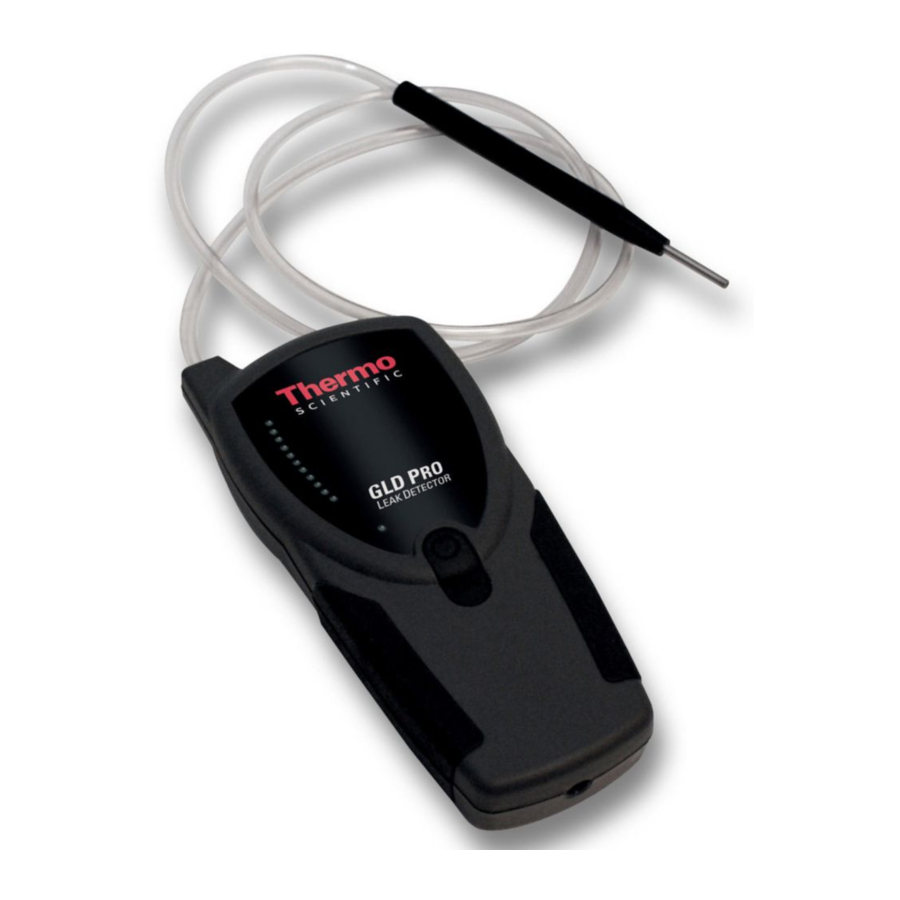Inhaltsverzeichnis
Werbung
Verfügbare Sprachen
Verfügbare Sprachen
Quicklinks
Werbung
Kapitel
Inhaltsverzeichnis
Fehlerbehebung

Inhaltszusammenfassung für Thermo Scientific GLD Pro
- Seite 15 Inhaltsverzeichnis Einführung Akku-Aufladung Einschalten Nullabgleich des Geräts Vor der Inbetriebnahme Erkennung von Lecks Technische Daten Wartung Fehlersuche 10.0 Technologie 11.0 Interpretation der Ergebnisse 12.0 Erklärung des Labels auf der Rückseite 13.0 Spezifikationen des Gehäuses 14.0 Service...
-
Seite 16: Einführung
Betriebsanleitung 1.0 Einführung Der Lecksucher von Thermo Scientific wurde speziell zur Verwendung mit gaschromatographischen (GC) Systemen entwickelt. Er detektiert kleine Lecks von Gasen, die eine andere Wärmeleitfähigkeit als Luft aufweisen. Der Referenzgas-Einlass (Abbildung 1) saugt Umgebungsluft an, die dann mit dem Gas in der Probensonde verglichen wird. -
Seite 17: Akku-Aufladung
2.0 Akku-Aufladung Der Lecksucher sollte vor der Verwendung voll aufgeladen sein. Verwenden Sie dazu bitte nur den AC-Adapter oder das USB-Kabel, die beide mit dem Gerät geliefert werden. Um den Akku mithilfe des AC-Adapters aufzuladen, befestigen Sie bitte zunächst den passenden Stecker für die Netzsteckdosen Ihres Landes am mitgelieferten AC-Adapter. -
Seite 18: Einschalten
3.0 Einschalten Drücken Sie den Betriebsschalter (Abbildung 1) und halten Sie ihn solange gedrückt, bis das Gerät eine etwa 15 Sekunden dauernde Startsequenz einleitet; während dieser Zeit blinken die roten und gelben LEDs. Während der Startsequenz darf das Gerät NICHT genullt werden. -
Seite 19: Erkennung Von Lecks
Der Lecksucher spricht auf praktisch jedes Gas an. Lösemitteldämpfe, Abgas aus Splitausgängen und sogar starke Luftströme um die Sonde oder den Referenzgas-Einlass können Instabilität verursachen oder falsche positive Messwerte liefern. Achten Sie darauf, dass bei der Prüfung auf Lecks keine Atemluft in den Referenzeinlass gelangt und blockieren oder decken Sie ihn nicht mit der Hand ab. -
Seite 20: Technische Daten
7.0 Technische Daten Nennleistung: 5 Volt DC, 1 A (AC-Adapter und USB-Ladekabel werden mitgeliefert) Akkuleistung: 12 Betriebsstunden Umgebungstemperatur: 10-37 °C (50-98,6 °F) Luftfeuchtigkeit: 0–97% Gewährleistung: 1 Jahr Zertifizierungen: CE (EU, Korea, Japan, Australien); CSA/UL-geprüft, nicht gelistet Konformität: WEEE, CEC, China RoHS 2 Höhe: bis zu 2000 m über dem mittleren Meeresspiegel Verschmutzungsgrad:... -
Seite 21: Fehlersuche
Angaben über Reparatur- oder Servicebetriebe* für Ihr Gerät finden Sie am Ende dieses Dokuments. Abbildung 2: Abgeschraubte und teilweise Abbildung 3: Entfernte Verschlusskappe, entfernte Verschlusskappe zur Reinigung freigelegte Bürste der Sondenspitze 9.0 Fehlersuche Störung Mögliche Ursache Vorgeschlagene Lösung Sonde verstopft Sondenspitze reinigen, um etwaige Verunreinigungen zu Beobachtete Änderung der... -
Seite 22: Technologie
10.0 Technologie Siehe Seite 9 11.0 Interpretation der Ergebnisse Abbildung 5 zeigt den Ansprechbereich der LED-Anzeigen des Lecksuchers. Eine größere Anzahl leuchtender roter oder gelber LED-Anzeigen korreliert in der Regel mit einem größeren Leck. HINWEIS: Der Lecksucher ist keine quantitative Vorrichtung, sondern dient lediglich zur Erkennung von Lecks an Gasleitungsanschlüssen, die oft an Laborgeräten zu finden sind. - Seite 23 Spitzenabweichung Das als Spitzenabweichung bezeichnete Phänomen tritt auf, wenn bei schneller Bewegung der Sonde oder des Geräts eine falsche Reaktion der LEDs registriert wird. Die Spitzenabweichung ist charakteristisch für die gesamte Lecksuchtechnik mit zwei Thermistoren und basiert zum großen Teil auf der Ungleichmäßigkeit der Flusszellen. Schütteln oder Kippen des Geräts beeinflusst das Strömungsprofil der Luft, was seinerseits die Geschwindigkeit des Wärmeaustausches beeinflusst.
-
Seite 24: Anmerkungen Auf Der Rückseite
12.0 Anmerkungen auf der Rückseite 1. Produktbezeichnung. 2. Artikelnummer des Produkts. 3. Seriennummer des Produkts. 4. Prüfung des Batterieladesystems (BCS, Battery Charging System) gemäß Richtlinie der Kalifornischen Energiebehörde (California Energy Commission - CEC) bestanden. 5. CE-Kennzeichen: siehe Konformitätserklärung 6. KC-Kennzeichen - Korea-Zertifizierung 7. -
Seite 25: Gehäusespezifikationen
SCHWARZ MIT MT-11030 OBERFLÄCHENSTRUKTUR 14.0 Service Der Lecksucher von Thermo Scientific ist durch eine einjährige Gewährleistung ab dem Zeitpunkt des Kaufes abgedeckt. Bei Anfragen an Thermo Fisher Scientific zu diesem Produkt sollten Sie die Seriennummer Ihres Lecksuchers bereithalten. Die erwartete Lebensdauer des Akkus beträgt zwei Jahre ab dem Zeitpunkt des Kaufes.

